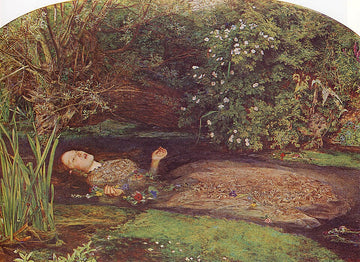A Missed Radio Show, Taylor Swift, and a Modern Take on The Fate of Ophelia!
by Ophelia Dadzie on Oct 10, 2025

I don’t check my phone messages often. Today, I finally caught up on a week’s worth—and one message made me smile. It was from a radio station inviting me to attend their show. Not because of my dermatological expertise, but because of my name: Ophelia. Apparently, Taylor Swift’s new album features a track titled The Fate of Ophelia, and they thought it would be fun to have an actual Ophelia on the show.
Of course, by the time I listened to the message, the event had already passed. But the call did prompt me to listen to the song—and that led me down a reflective path. I found myself thinking about the emotional experiences of the original Ophelia from Shakespeare’s Hamlet, and wondering how a modern-day Ophelia might navigate the same emotional landscape. How differently might her story unfold today?
With these thoughts stirring, I thought it only appropriate to write down my reflections—especially on World Mental Health Day. After all, Ophelia’s story has long been entangled with themes of emotional distress, fragility, and misunderstood suffering. What might her journey have looked like in a world with more awareness and compassion?
The modern Ophelia no longer drowns in silence. She sits with the weight of her grief and begins to trace it backward—not to Hamlet, but to her childhood home. She remembers how she grew up feeling and thinking that love was conditional, and that her worth was measured in obedience and gentleness, in pleasing others. How being unseen became a way of survival.
When both her brother Laertes and her father Polonius warn her not to see Hamlet, both are controlling and use her for their own purposes, failing to acknowledge her wishes and desires—as portrayed in Shakespeare’s original play.
As she looks back, she recognises now that this is where her attachment wounds began—the anxious need to please, the fear of abandonment, and the belief that love had to be earned, not given freely.
When Hamlet appeared, their connection was magnetic. His volatility felt familiar—the push and pull, the warmth and then distance—these were all replaying her emotional world from childhood, mirroring her earliest lessons in love. But now, with awareness, she knows their connection, while magnetic, was not healthy—it was a trauma bond. The magnetic pull between two unhealed hearts, born of chaos, searching for safety in each other.
In another life, she might have tried to rescue or fix him. She would have poured herself into him, hoping that her love could anchor him. Hoping that this time, she would earn the love she so desperately wanted. But this Ophelia is wiser. She understands that healing cannot be done on someone’s behalf. She understands that this healing journey is for Hamlet alone to take. She understands that salvation offered to another before it’s granted to oneself only deepens the wound.
So as Hamlet cruelly rejects her, she does not beg or chase. She steps back with dignity. She accepts the grief and sits with her grief, but does not let it consume her. She does not look for a rescuer externally, but knows her rescue is internal. She turns inward—and meets the small, frightened girl who was never taught that love was unconditional, and that she was worthy just as she is.
She begins to reparent the little girl—she listens to her and teaches her about self-worth and self-respect, about boundaries, and that solitude can be sacred.
She does not forget Hamlet—she holds compassion for him and realises his cruel rejection of her was not a sign of her unworthiness, but of his limitations. His inability to hold emotional intimacy. His fear of vulnerability born of his childhood wounds. The loss of trust, grief, and betrayal Hamlet felt as he lost his father and observes his mother (Queen Gertrude) marrying his uncle Claudius within a short space of time—as told in Shakespeare’s tragedy—deeply shaped him.
She understands the depth of the wounds Hamlet has faced. She prays that he too will have the courage to face his deep pain, and learn that vulnerability is not weakness, but the doorway to love.
The modern-day Ophelia does not hold tightly to the love she had for Hamlet, but recognises that while love can be honoured, it cannot be possessed. She knows that only when both have met themselves—fully, honestly, and without fear—could love between them ever be whole.
Until then, Ophelia chooses peace, growth, and self-connection instead of passion, longing, or rescue.
Ophelia no longer sinks beneath the water—but walks out of it, reborn.
In the end, modern-day Ophelia understands that no lover, no apology, and no return could heal what was never another’s to fix. Salvation does not arrive in another person’s arms—it rises quietly within, the moment she decides to no longer abandon herself, but to respect herself. She realises that she was never meant to drown for love—but to learn that love begins in the act of reaching for her own hand.
And as she chooses herself—wholly, and without hesitation—she becomes what she once searched for: the steady presence that will never leave her.
Oh—how I wish Taylor Swift had re-written The Fate of Ophelia as an anthem of self-love, rather than one of external rescue. Parents need to show and teach their children that love is not earned but is given freely—and that vulnerability is not weakness, but strength.
If I am ever invited back onto the radio show (and I check my phone messages on time), this will be my take on The Fate of Ophelia.





